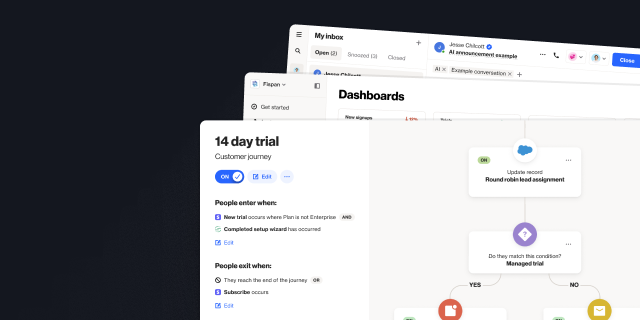How to implement web visitor tracking

Ortto’s tracking code enables you to track known and anonymous visitor activity, capture lead and contact data, and display targeted messages or capture widgets. And, unlike other universal tracking codes, Ortto’s Checkmate Tracking can’t be blocked by people using ad blockers, resulting in higher CTRs (click-through rates) based on domain trust.
By default, a website session tracking code is created for all Ortto accounts, and you can find installation instructions by clicking on the website session tracking data source. If you’re using a data source like Shopify, BigCommerce or PrestaShop, your tracking code will be automatically installed and will work with no additional setup required.
User session association requires a tweak to the tracking code that is placed on your website. Visit our help pages to see which code needs to be replaced to associate a known user session by email address or external ID.
With this tracking code implemented, you’ll be able to:
Track known and anonymous visitor activity on any site with the code
Capture leads and contact data from nearly any web form
Display onsite messages on specific or all tracked pages
Enable automatic UTM parameter tracking
Segment and/or score contacts based on website visits
Display highly targeted in-product messages
1. Track anonymous and known visitor activity on your website
All visitors to your tracked pages are initially treated as anonymous and assigned a unique ID number.
In Ortto, once a visitor becomes known, all of their previous anonymous browsing history will be connected to their contact record. Plus, their future activity will appear alongside their known name in your activity feed.
As the contact engages with your website, content, and messages, Ortto tracks their interactions and aggregates them in her contact profile.
This contact record activity feed will help you understand your customer’s entire journey, targeting relevant messages at the right time, in the right place.
2. Capture leads directly in Ortto
So how do anonymous visitors turn into known contacts in the first place? With the tracking code in place, you unlock a number of key features that will enable you to ‘session’ or convert anonymous visitors into known contacts:
Form capture
Email engagement
Pop-ups
Form capture
Let’s say your skincare company sends an email newsletter. After visiting your blog or being enticed by your remarkable website experience, visitors can subscribe to your newsletter from a number of pages or pop-ups on site.
Using Ortto’s form capture feature, you can collect form field data (e.g. first name, email) from any form that resides on a page that’s running the tracking code. You can then trigger automated journeys or update and segment your contacts upon form submission.

Email engagement
Another way to convert anonymous visitors into known users is using email engagement. When a contact who hasn’t already been sessioned clicks a link within an email sent using Ortto, the tracking code is embedded and the user is sessioned via their email address.
This allows you to track:
Contacts from uploaded email lists (e.g., from a trade show): You already have permission to email them. Now you can track their online behavior by getting them to click a link in your follow-up email campaign, which automatically embeds the tracking code.
Contacts who have cleared their browser cookies. Their email address may be in Ortto, but since the tracking code relies on cookies, their web visits register as anonymous.
Contacts who received the email in a different browser or device (i.e. Firefox instead of Chrome). Because each browser has its own cookies, Ortto won’t immediately recognize contacts browsing your website from a new browser. But if that contact clicks on a link in an email sent by Ortto from this new browser, the tracking code on the page clicked through to will associate the new cookies with your account, converting the contact from an anonymous visitor into a known visitor. The same principles apply to different devices.
Pop-ups
The tracking code enables you to display onsite and in-app pop-up messages.
Pop-ups can be shown to anonymous visitors or known visitors. For example, our fictitious skincare store could display a variety of pop-ups messages:
Link shoppers to a 24-hour sale with a Countdown pop-up
Use a Survey to find out why a customer didn’t checkout after adding something to cart
Display a ‘how to find your size’ video when a user has been sitting on a product page for a certain amount of time
Give shoppers a 10% off coupon if they subscribe to your newsletter

Each time you set up a pop-up, you’ll want to consider the journeys your contacts are in, the actions they’ve taken, and their attributes. Taking those elements into account leads to personalized, contextual messaging.
3. Enable automatic UTM parameter tracking
UTM parameters are snippets of text that, when added to a link, tell Ortto (and other tools, like Google Analytics) more information about the visitor, such as where they came from, what medium they engaged with, and what they’re interested in. When visitors click on one of these custom links, the unique parameters are sent to your Ortto account for easy access.
A URL with UTM parameters looks like this:
http://yourwebsite.com/?utm_source=ortto&utm_medium=email&utm_campaign=skinimalism&utm_term=sunscreen
In this case, the following information is sent via the parameters:
Source: Ortto
Medium: Email
Campaign: Skinimalism
Term: Sunscreen
Since Ortto’s tracking code captures UTM parameters from visits to web pages, you can find out how different campaigns are performing.
You can see whether your user visited a URL with a UTM parameter, and cross-reference UTM parameters with paying customers to find out which campaigns led to sales.
Ortto also captures UTM parameters included in links in emails sent via Ortto. The benefit of this is that UTM parameters can be captured when contacts click through to web pages that don’t have your tracking code.
Finally, with automated UTM parameter tracking, you can change a contact’s path in a journey using the ‘has visited page’ condition and/or the ‘is on list or segment’ condition.
4. Unlock the ability to segment contacts based on page visits
The tracking code monitors page visits, but it also makes it easy to segment contacts based on those page visits.
This opens up a world of possibilities for our skincare company when it comes to personalized marketing efforts:
Visitors to the Sunscreen page could, after five visits, receive an email with the top three items in that category
Visitors who viewed but didn’t buy the Sleeping Mask could receive an automated discount via email after a three-hour delay
Visitors who haven’t come back to the website for more than two days could receive a 20% discount
Visitors who view the events page could receive a personal invitation to an upcoming event, but only if they live in New York City, Brooklyn or Queens
5. Display highly targeted in-product messages
The tracking code not only unlocks personalized messaging for typical websites, but also for in-product experiences.
With that in mind, imagine our skincare company has launched an app that uses AI to analyze skin health and track it over time to see which products make a difference and how consistent use of sunscreen protects your skin from aging. We’re giving every customer a two-week free trial, and the opportunity to extend that free trial by one week if they recruit a friend.
In-product messages could include:
Personalized welcome email or pop-up message as soon as a person signs up for a free trial, asking them to invite a friend to score another free week
Notifications announcing new features
Proactive assistance from support after the tracking code picks up on a user visiting the help center
Conversion nudges to move to a paid plan when the user’s free trial is coming to an end
Targeted surveys and feedback forms to gather intel on the new product
Whether you are targeting ecommerce customers or product users, the website tracking code has you covered.
The final word
Adding a website tracking code is essential to tracking even the most basic information like website traffic and source, but with a powerful CDP and marketing automation platform like Ortto, it unlocks a whole world of growth.
To get started, visit our pricing page to compare plans and find the right solution for your business.


“We were looking for a solution that was really easy to use, didn’t require a tech team, and would have a robust integration with Salesforce so we could trigger sales communications in a smarter way. Nobody else out there has what Ortto has.”

Try Ortto today
Build a better journey.

Product
Pricing
Solutions
Features
About
Resources
Ortto for
Templates
Integrations








